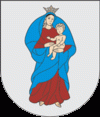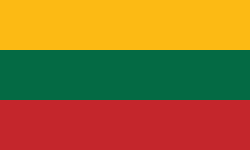Kretinga
 |
The population was listed as 21,421 in the 2006 census. It is the 6th largest town in the ethnographic region of Samogitia and the 17th largest town in Lithuania.
Kretinga is one of the oldest known towns in Lithuania. It was first mentioned in 1253 as castle of Cretyn under the charter of Bishop Heinrich of Courland.
In 1602, Jan Karol Chodkiewicz built the first wooden church in Kretinga and established a Benedictine monastery, which became a great success. After about ten years a new brick church with an impressive organ was built. In 1610 a church school was opened.
In 1609, Jan Karol Chodkiewicz announced that he would establish a new settlement next to the old village and would grant the new borough Magdeburg rights. The new borough adopted a coat of arms depicting the Blessed Virgin Mary with the Infant Jesus in her arms. Kretinga's patron saint remains the Blessed Virgin.
In 1621, the Sapieha family gained control of the city; they changed its coat of arms to represent Saint Casimir. In 1659 and 1710 the church and monastery were destroyed by Swedish armies. The Sapieha family helped to rebuild and improve it.
In 1720, the town came under the jurisdiction of the Massalski family. Ignacy Jakub Massalski opened a university preparatory school in 1774. The town lost its municipal rights after the partitions of the Polish–Lithuanian Commonwealth.
The town prospered during the 19th century as part of the Russian Empire. In 1882 the first telephone line in Lithuania connected Kretinga with Plungė and Rietavas. In 1875, Count Tiškevičius decided to establish his family estate in Kretinga; he purchased and rebuilt an old palace. Following the fashions of the Victorian era, the family landscaped it lavishly and built a greenhouse featuring exotic flowering plants and tropical fruits. In 1890 they installed electricity in the Manor House.
During World War I, the Germans built a railway line connecting Bajorai, Kretinga, and the Latvian city of Priekule. In 1924 Kretinga regained its municipal rights. During the interwar period, the village of Kretingsodis, on the other side of the Akmena River, was incorporated into the borough. Kretinga gained greater importance after another railway line was built in 1932 that connected it to Šiauliai.
During the first Soviet occupation, under the Molotov–Ribbentrop Pact, a reign of terror resulted in local residents being arrested and, in some cases, executed without trial or deported to Siberia. A local lawyer, Vladas Petronaitis, was arrested and ultimately tortured to death by the Soviet intelligence agency.
Map - Kretinga
Map
Country - Lithuanian_Soviet_Socialist_Republic_(1918–1919)
 |
 |
| Flag of Lithuania | |
Germany had lost World War I and signed the Compiègne Armistice on 11 November 1918. Its military forces then started retreating from the former Ober Ost territories. Two days later, the government of the Soviet Russia renounced the Treaty of Brest-Litovsk, which had assured Lithuania's independence. Soviet forces then launched a westward offensive against Estonia, Latvia, Lithuania, Poland and Ukraine in an effort to spread the global proletarian revolution and replace national independence movements with Soviet republics. Their forces followed retreating German troops and reached Lithuania by the end of December 1918.
Currency / Language
| ISO | Currency | Symbol | Significant figures |
|---|---|---|---|
| EUR | Euro | € | 2 |
| ISO | Language |
|---|---|
| LT | Lithuanian language |
| PL | Polish language |
| RU | Russian language |















